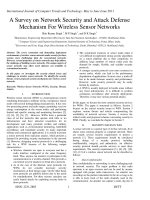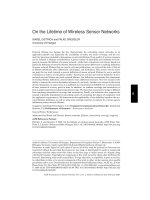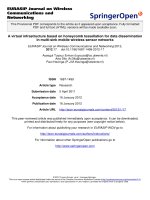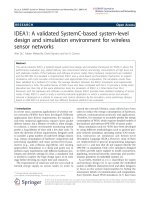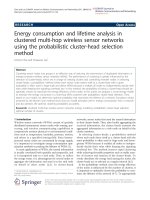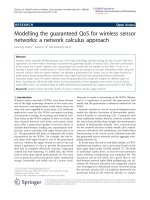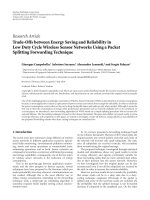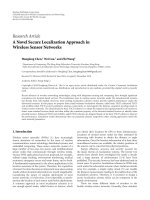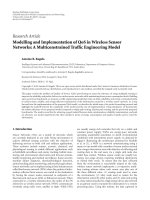Multi agent systems on wireless sensor networks a distributed reinforcement learning approach
Bạn đang xem bản rút gọn của tài liệu. Xem và tải ngay bản đầy đủ của tài liệu tại đây (1.01 MB, 139 trang )
MULTI-AGENT SYSTEMS
ON WIRELESS SENSOR NETWORKS:
A DISTRIBUTED
REINFORCEMENT LEARNING APPROACH
JEAN-CHRISTOPHE RENAUD
NATIONAL UNIVERSITY OF SINGAPORE
2006
MULTI-AGENT SYSTEMS
ON WIRELESS SENSOR NETWORKS:
A DISTRIBUTED
REINFORCEMENT LEARNING APPROACH
JEAN-CHRISTOPHE RENAUD
(B.Eng. Institut National des T´el´ecommunications, France)
A THESIS SUBMITTED
FOR THE DEGREE OF MASTER OF ENGINEERING
DEPARTMENT OF ELECTRICAL & COMPUTER ENGINEERING
NATIONAL UNIVERSITY OF SINGAPORE
2007
Acknowledgments
I consider myself extremely fortunate for having been given the opportunity and privilege
of doing this research work at the National University of Singapore (NUS) as part of the
Double-Degree program between NUS and the French “Grandes Ecoles”. This experience
has been a most valuable one.
I wish to express my deepest gratitude to my Research Supervisor Associate Professor
Chen-Khong Tham for his expertise, advice, and support throughout the progress of this
work. His kindness and optimism created a very motivating work environment that made
this thesis possible.
Warm thanks to Lisa, who helped me finalize this work by reading and commenting
it and for listening to my eternal, self-centered ramblings. I would also like to express my
gratitude to all my friends with whom I discovered Singapore.
Finally, I would like to thank my wonderful family, in Redon and Paris, for providing
the love and encouragement I needed to leave my home country for Singapore and complete
this Master. I dedicate this work to them.
i
A mes parents.
Contents
Acknowledgments
Contents
i
ii
Summary
vii
List of Tables
ix
List of Figures
x
List of Abbreviations
xii
Declaration
xiv
1 Introduction
1
1.1
Wireless Sensor Networks and Multi-Agent Systems . . . . . . . . . . . . .
1
1.2
Challenges with Multi-Agent Systems . . . . . . . . . . . . . . . . . . . . .
4
1.3
Reinforcement Learning . . . . . . . . . . . . . . . . . . . . . . . . . . . . .
6
1.4
Markov Decision Processes . . . . . . . . . . . . . . . . . . . . . . . . . . . .
9
1.5
1.4.1
Value functions . . . . . . . . . . . . . . . . . . . . . . . . . . . . . . 10
1.4.2
The Q-learning algorithm . . . . . . . . . . . . . . . . . . . . . . . . 11
Focus, motivation and contributions of this thesis . . . . . . . . . . . . . . . 12
ii
CONTENTS
2 Literature review
16
2.1
Multi-agent Learning . . . . . . . . . . . . . . . . . . . . . . . . . . . . . . . 17
2.2
Solutions to the curse of dimensionality . . . . . . . . . . . . . . . . . . . . 18
2.3
2.4
2.5
2.2.1
Independent vs. cooperative agents . . . . . . . . . . . . . . . . . . . 18
2.2.2
Global optimality by local optimizations . . . . . . . . . . . . . . . . 19
2.2.3
Exploiting the structure of the problem . . . . . . . . . . . . . . . . 22
Solutions to partial observability . . . . . . . . . . . . . . . . . . . . . . . . 28
2.3.1
Partially Observable MDPs . . . . . . . . . . . . . . . . . . . . . . . 29
2.3.2
Multi-agent learning with communication . . . . . . . . . . . . . . . 31
Other approaches . . . . . . . . . . . . . . . . . . . . . . . . . . . . . . . . . 35
2.4.1
The Game theoretic approach . . . . . . . . . . . . . . . . . . . . . . 35
2.4.2
The Bayesian approach . . . . . . . . . . . . . . . . . . . . . . . . . 37
Summary . . . . . . . . . . . . . . . . . . . . . . . . . . . . . . . . . . . . . 38
3 Distributed Reinforcement Learning Algorithms
3.1
40
The common multi-agent extensions to Reinforcement Learning . . . . . . . 41
3.1.1
The centralized approach and the independent Q-learners algorithm
42
3.1.2
The Global Reward DRL algorithm . . . . . . . . . . . . . . . . . . 42
3.2
Schneider et al.’s Distributed Value Function algorithms . . . . . . . . . . . 43
3.3
Lauer and Riedmiller’s optimistic assumption algorithm . . . . . . . . . . . 45
3.4
3.3.1
General framework: Multi-Agent MDP . . . . . . . . . . . . . . . . . 45
3.3.2
The Optimistic DRL algorithm . . . . . . . . . . . . . . . . . . . . . 46
Kapetanakis and Kudenko’s FMQ heuristic . . . . . . . . . . . . . . . . . . 48
3.4.1
Extensions of the FMQ heuristic to multi-state environments . . . . 50
iii
CONTENTS
3.5
Guestrin’s Coordinated Reinforcement Learning . . . . . . . . . . . . . . . . 50
3.5.1
Description of the approach . . . . . . . . . . . . . . . . . . . . . . . 51
3.5.2
The Variable Elimination algorithm . . . . . . . . . . . . . . . . . . 51
3.5.3
The Coordinated Q-Learning algorithm . . . . . . . . . . . . . . . . 53
3.6
Bowling and Veloso’s WoLF-PHC algorithm . . . . . . . . . . . . . . . . . . 54
3.7
Summary and conclusion
3.7.1
. . . . . . . . . . . . . . . . . . . . . . . . . . . . 56
Conclusion . . . . . . . . . . . . . . . . . . . . . . . . . . . . . . . . 58
4 Design of a testbed for distributed learning of coordination
4.1
4.2
4.3
4.4
59
The multi-agent lighting grid system testbed . . . . . . . . . . . . . . . . . 60
4.1.1
State-action spaces . . . . . . . . . . . . . . . . . . . . . . . . . . . . 60
4.1.2
Reward functions . . . . . . . . . . . . . . . . . . . . . . . . . . . . . 62
4.1.3
Analysis of the light-grid problem for the CQL algorithm . . . . . . 63
Distributed learning of coordination . . . . . . . . . . . . . . . . . . . . . . 66
4.2.1
Single optimal joint-action setting . . . . . . . . . . . . . . . . . . . 66
4.2.2
Multiple optimal joint-actions settings . . . . . . . . . . . . . . . . . 67
Deterministic and stochastic environments . . . . . . . . . . . . . . . . . . . 68
4.3.1
Deterministic environments . . . . . . . . . . . . . . . . . . . . . . . 69
4.3.2
Stochastic environments . . . . . . . . . . . . . . . . . . . . . . . . . 69
Summary . . . . . . . . . . . . . . . . . . . . . . . . . . . . . . . . . . . . . 72
iv
CONTENTS
5 Implementation on actual sensor motes and simulations
5.1
73
Generalities . . . . . . . . . . . . . . . . . . . . . . . . . . . . . . . . . . . . 74
5.1.1
Software and Hardware . . . . . . . . . . . . . . . . . . . . . . . . . 74
5.1.2
Parameters used in the simulations . . . . . . . . . . . . . . . . . . . 75
5.2
Energy considerations . . . . . . . . . . . . . . . . . . . . . . . . . . . . . . 76
5.3
Results for the Deterministic environments . . . . . . . . . . . . . . . . . . 79
5.4
5.5
5.6
5.3.1
Convergence and speed of convergence of the algorithms for the Deterministic environments . . . . . . . . . . . . . . . . . . . . . . . . . 79
5.3.2
Application-level results . . . . . . . . . . . . . . . . . . . . . . . . . 83
Results for Partially Stochastic environments . . . . . . . . . . . . . . . . . 86
5.4.1
Convergence and speed of convergence of the algorithms for the Partially Stochastic environments . . . . . . . . . . . . . . . . . . . . . . 86
5.4.2
Application-level results . . . . . . . . . . . . . . . . . . . . . . . . . 88
Results for Fully Stochastic environments . . . . . . . . . . . . . . . . . . . 91
5.5.1
Convergence and speed of convergence of the algorithms for Fully
Stochastic environments . . . . . . . . . . . . . . . . . . . . . . . . . 91
5.5.2
Application-level results . . . . . . . . . . . . . . . . . . . . . . . . . 93
5.5.3
Influence of stochasticity over the convergence performance of the
DRL algorithms . . . . . . . . . . . . . . . . . . . . . . . . . . . . . 96
Conclusion . . . . . . . . . . . . . . . . . . . . . . . . . . . . . . . . . . . . 98
6 Conclusions and Future Work
101
6.1
Contributions of this work . . . . . . . . . . . . . . . . . . . . . . . . . . . . 101
6.2
Directions for future work . . . . . . . . . . . . . . . . . . . . . . . . . . . . 103
Bibliography
105
v
CONTENTS
APPENDIX
117
Appendix A - Pseudo-code of the DRL algorithms . . . . . . . . . . . . . . . . . 117
A-1
Independent Q-Learning and GR DRL . . . . . . . . . . . . . . . . . 117
A-2
Distributed Value Function DRL - Schneider et al. . . . . . . . . . . 118
A-3
Optimistic DRL - Lauer and Riedmiller . . . . . . . . . . . . . . . . 119
A-4
WoLF-PHC - Bowling and Veloso
A-5
FMQ heuristics extended from Kudenko and Kapetanakis . . . . . . 120
A-6
Coordinated Q-Learning - Guestrin . . . . . . . . . . . . . . . . . . . 121
Appendix B - List of Publications
. . . . . . . . . . . . . . . . . . . 119
. . . . . . . . . . . . . . . . . . . . . . . . . . 122
B-1
Published paper . . . . . . . . . . . . . . . . . . . . . . . . . . . . . 122
B-2
Pending Publication . . . . . . . . . . . . . . . . . . . . . . . . . . . 122
B-3
Submitted paper . . . . . . . . . . . . . . . . . . . . . . . . . . . . . 122
vi
Summary
Implementing a multi-agent system (MAS) on a wireless sensor network comprising sensoractuator nodes is very promising as it has the potential to tackle the resource constraints
inherent in wireless sensor networks by efficiently coordinating the activities among the
nodes. In fact, the processing and communication capabilities of sensor nodes enable them
to make decisions and perform tasks in a coordinated manner in order to achieve some
desired system-wide or global objective that they could not achieve by their own.
In this thesis, we review the research work about multi-agent learning and learning of
coordination in cooperative MAS. We then study the behavior and performance of several distributed reinforcement learning (DRL) algorithms: (i) fully distributed Q-learning
and its centralized counterpart, (ii) Global Reward DRL, (iii) Distributed Reward and
Distributed Value Function, (iv) Optimistic DRL, (v) Frequency Maximum Q-learning
(FMQ) that we have extended to multi-stage environments, (vi) Coordinated Q-Learning
and (vii) WoLF-PHC. Furthermore, we have designed a general testbed in order to study
the problem of coordination in a MAS and to analyze more into detail the aforementioned
DRL algorithms. We present our experience and results from simulation studies and actual
vii
SUMMARY
implementation of these algorithms on Crossbow Mica2 motes, and compare their performance in terms of incurred communication and computational costs, energy consumption
and other application-level metrics. Issues such as convergence to local or global optima,
as well as speed of convergence are also investigated. Finally, we discuss the trade-offs
that are necessary when employing DRL algorithms for coordinated decision-making tasks
in wireless sensor networks when different level of resource-constraints are considered.
viii
List of Tables
4.1
Characteristics of Setting 1. . . . . . . . . . . . . . . . . . . . . . . . . . . . 67
4.2
Characteristics of Setting 2. . . . . . . . . . . . . . . . . . . . . . . . . . . . 67
4.3
Characteristics of Setting 3. . . . . . . . . . . . . . . . . . . . . . . . . . . . 68
4.4
Characteristics of Setting 4. . . . . . . . . . . . . . . . . . . . . . . . . . . . 68
4.5
Partially Stochastic environments. . . . . . . . . . . . . . . . . . . . . . . . 70
4.6
Table T: Stochasticity on the performed action by a mote. . . . . . . . . . . 71
5.1
Energy Consumption (J) of the MAS with 5 motes during the first 60,000
iterations. . . . . . . . . . . . . . . . . . . . . . . . . . . . . . . . . . . . . . 77
5.2
Application-level performance of the MAS with 5 motes during the first
60,000 iterations, Deterministic environments. . . . . . . . . . . . . . . . . . 84
5.3
Average cost of the DRL algorithms over 2,000 runs of 60,000 steps, Deterministic environments. . . . . . . . . . . . . . . . . . . . . . . . . . . . . . . 85
5.4
Application-level performance of the MAS with 5 motes during the first
60,000 iterations, Partially Stochastic environments. . . . . . . . . . . . . . 88
5.5
Average cost of the DRL algorithms over 2,000 runs of 60,000 steps, Partially Stochastic environments. . . . . . . . . . . . . . . . . . . . . . . . . . 90
5.6
Application-level performance of the MAS with 5 motes during the first
60,000 iterations, Fully Stochastic environments. . . . . . . . . . . . . . . . 94
5.7
Average cost of the DRL algorithms over 2,000 runs of 60,000 steps, Fully
Stochastic environments. . . . . . . . . . . . . . . . . . . . . . . . . . . . . . 95
5.8
Table T(ρ): Stochasticity on the performed action by a mote. Stochasticity
rate: ρ. . . . . . . . . . . . . . . . . . . . . . . . . . . . . . . . . . . . . . . 96
5.9
Summary of the convergence results. . . . . . . . . . . . . . . . . . . . . . . 98
ix
List of Figures
1.1
Abstract view of a 2-agent system. . . . . . . . . . . . . . . . . . . . . . . .
5
1.2
Abstract view of an agent in its environment in the RL framework. . . . . .
8
1.3
Single-agent Q-learning with -greedy exploration. . . . . . . . . . . . . . . 12
3.1
Optimistic assumption projection. . . . . . . . . . . . . . . . . . . . . . . . 47
3.2
Pseudo-code of the Variable Elimination algorithm. . . . . . . . . . . . . . . 52
3.3
WoLF-PHC algorithm for agent i. . . . . . . . . . . . . . . . . . . . . . . . 55
3.4
Scalability analysis of the DRL algorithms with respect to the size of the
action space (left) and the size of the state space (right). . . . . . . . . . . . 57
3.5
Taxonomy of the DRL algorithms studied in this thesis. . . . . . . . . . . . 58
4.1
Testbed: simulated room represented by a 10×10 grid. Dark blue cells
are dim, light blue cells are illuminated by one mote and striped cells are
illuminated by two motes. . . . . . . . . . . . . . . . . . . . . . . . . . . . . 60
4.2
5-agent light-grid system: (a) Coordination graph (b) Local Dynamic Decision Network (DDN) component for agent M1 (c) Global Dynamic Decision
Network (DDN) of the light-grid problem. . . . . . . . . . . . . . . . . . . . 64
4.3
Optimal equilibria for Setting 2 corresponding to joint-actions (a) 02222
and (b) 11122. . . . . . . . . . . . . . . . . . . . . . . . . . . . . . . . . . . 68
5.1
Average number of messages communicated between agents running the
DRL algorithms at each iteration (average over 60,000 iterations). . . . . . 78
x
LIST OF FIGURES
5.2
Percentage of convergence achieved by the 5-agent system running the DRL
algorithms during the first 60,000 iterations for the four Deterministic settings (average over 2,000 runs). . . . . . . . . . . . . . . . . . . . . . . . . . 80
5.3
Convergence of the parameters used in the linear approximation of the
global Q-function in the CQL algorithm (Deterministic settings). . . . . . . 83
5.4
Average cost of the DRL algorithms over 2,000 runs of 60,000 steps, Deterministic environments. . . . . . . . . . . . . . . . . . . . . . . . . . . . . . . 85
5.5
Percentage of convergence achieved by the 5-agent system running the DRL
algorithms during the first 60,000 iterations for the four Partially Stochastic
settings (average over 2,000 runs). . . . . . . . . . . . . . . . . . . . . . . . 86
5.6
Average cost of the DRL algorithms over 2,000 runs of 60,000 steps for
Partially Stochastic environments. . . . . . . . . . . . . . . . . . . . . . . . 90
5.7
Percentage of convergence achieved by the 5-agent system running the DRL
algorithms during the first 60,000 iterations for the four Fully Stochastic
settings (average over 2,000 runs). . . . . . . . . . . . . . . . . . . . . . . . 91
5.8
Comparison of the convergence of the parameters used in the linear approximation of the global Q-function in the CQL algorithm achieved in Setting 4
in Deterministic environment (left) and Fully Stochastic environment (right). 93
5.9
Average cost of the DRL algorithms over 2,000 runs of 60,000 steps for Fully
Stochastic environments. . . . . . . . . . . . . . . . . . . . . . . . . . . . . . 95
5.10 Influence of stochasticity over the performance of the DRL algorithms. . . . 97
A-I IL algorithm for agent i. . . . . . . . . . . . . . . . . . . . . . . . . . . . . . 117
A-II DVF algorithm for agent i. . . . . . . . . . . . . . . . . . . . . . . . . . . . 118
A-IIIOptDRL algorithm for agent i. . . . . . . . . . . . . . . . . . . . . . . . . . 119
A-IV FMQg algorithm for agent i. . . . . . . . . . . . . . . . . . . . . . . . . . . . 120
A-V CQL algorithm for agent i. . . . . . . . . . . . . . . . . . . . . . . . . . . . 121
xi
List of Abbreviations
WSN(s)
Wireless Sensor Network(s)
MAS
Multi-Agent System(s)
RL
Reinforcement Learning
DRL
Distributed Reinforcement Learning
MDP(s)
Markov Decision Process(es)
CG(s)
Coordination Graph(s)
VE
Variable Elimination algorithm
HRL
Hierarchical Reinforcement Learning
POMDP(s)
Partially Observable MDP(s)
IL
Independent Q-Learning algorithm
GR DRL
Global Reward DRL algorithm
DVF
Distributed Value Function algorithm
DR
Distributed Reward algorithm
OptDRL
Optimistic assumption DRL algorithm
FMQ
Frequency Maximum Q-learning heuristic
FMQg
Extended FMQ using global state information
FMQl
Extended FMQ using local state information
xii
LIST OF ABBREVIATIONS
CQL
Coordinated Q-Learning algorithm
DDN
Dynamic Decision Network
DBN
Dynamic Bayesian Network
xiii
Declaration
Parts of this thesis have been published previously or are pending for publication in collaboration with Associate Professor Chen-Khong Tham.
In particular, the work presented in Chapter 4 concerning the IL, DVF and OptDRL
algorithms in Deterministic environments was published in 2005 at the Second International Conference on Intelligent Sensors, Sensor Networks and Information Processing
(ISSNIP 2005) that was held in Melbourne, Australia during December 5-8, 2005 (Tham
& Renaud 2005).
In addition, results about the IL, DVF, OptDRL and FMQg algorithms for Deterministic and Partially Stochastic environments will appear in the 14th IEEE International
Conference On Networks (ICON 2006) proceedings (Renaud & Tham 2006). The ICON
2006 conference will be held in Singapore during September 13-15, 2006.
Except where otherwise stated, all material is the author’s own.
xiv
Chapter 1
Introduction
This Chapter provides a brief overview of the general principles of single-agent RL methods. The focus is on problems in which the consequences (rewards) of selecting an action
can take place arbitrarily far in the future. The mathematical tool for modeling delayed reward problems are Markov Decision Processes (MDPs) and thus the approaches discussed
here are based on MDPs. The most prominent learning algorithm for Reinforcement
Learning (RL), Q-learning, is presented in Section 1.4.2 along with some of the theoretical
foundations on which this type of learning is based.
1.1
Wireless Sensor Networks and Multi-Agent Systems
Wireless Sensor Networks (WSNs) is a recent and significant improvement over traditional
sensor networks arising from advances in wireless communications, microelectronics and
miniaturized sensors. In fact, these low power, multi-functional sensor nodes are tiny in
1
1.1. Wireless Sensor Networks and Multi-Agent Systems
CHAPTER: 1
size, have embedded processing as well as communication capabilities and present a wide
range of applications from health to home, from environmental to military or from traffic
to other commercial applications. The main challenges in WSNs stem from their limited
resources. Actual commercialized motes such as Crossbow Mica2 motes (the current research and industry leading hardware and software platform) [1] are small devices with
limited and generally irreplaceable battery power, small memory, constrained computational capacities and transmission bandwidth, etc. Moreover, being inexpensive devices,
sensor nodes are prone to failures. The most general concept is to have a large number of
wireless sensor nodes spread out in an environment for monitoring or tracking purposes.
Most of the research work on sensor networks focuses on techniques to relay sensed information in an energy-efficient manner to a central base station. In addition, methods
for collaborative signal and information processing (CSIP) [2] which attempt to perform
processing in a distributed and collaborative manner among several sensor nodes have also
been proposed.
A distributed approach to decision-making using WSNs is attractive for several reasons. First, sensing entities are usually spatially distributed, thus forming distributed
systems for which a decentralized approach is more natural. Second, sensor networks can
be very large, i.e. containing hundreds or thousands of nodes; consequently, a distributed
solution would always be more scalable than a centralized one. Finally, a distributed approach is compatible with the resource-constrained nature of sensor nodes.
Therefore, a decentralized approach to performing computation, i.e. using distributed
algorithms, and limiting the amount and distance of communication are necessary design parameters in order to achieve an efficient, energy-aware and scalable solution. Fur-
2
1.1. Wireless Sensor Networks and Multi-Agent Systems
CHAPTER: 1
thermore, the restricted communication bandwidth and range in WSNs would exclude a
centralized approach.
Implementing a Multi-Agent System (MAS) for distributed systems is a useful (if
not saying a required) solution that presents numerous advantages. In fact, the different
entities of a distributed system often need their own systems to reflect their internal
structures, actions, goals and domain knowledge: MAS are particularly suited for this
modular representation and are practical to handle the interactions between these entities.
Having multiple agents can also speed up the system’s learning by providing a method for
concurrent learning. Another advantage of MAS is their scalability: it is easier to add new
agents to a MAS than it is to add new abilities to an existing monolithic system. Systems
like WSNs whose capabilities and parameters are likely to change over time or across
agents can gain from this benefit of MAS. Moreover, MAS are usually more robust than
their single-agent counterparts: they indeed distribute the tasks of the system between
several agents and enable redundancy of operations and capabilities by having several
identical agents. MAS can therefore be a solution to nodes failures. In addition, they
avoid the risk of having one centralized system that could be a performance bottleneck or
could fail at critical times. Finally, MAS are usually simpler to program by distributing
the system’s functions among several agents.
All of the above advantages of MAS make them a practical and suitable approach to
distributed decision-making on WSNs. However, implementing a MAS on a WSN does
not come without specific issues.
3
1.2. Challenges with Multi-Agent Systems
1.2
CHAPTER: 1
Challenges with Multi-Agent Systems
Although MAS provide many potential advantages as aforementioned, the conceptualization, design and implementation of a MAS arise a number of challenges [3], [4]. These
include the need for a proper formulation, description and decomposition of the overall
task into sub-tasks assigned to the agents. Usually agents have an incomplete view of the
environment: they therefore have to inter-operate and coordinate their strategies in order
to coherently and efficiently solve complex problems and avoid harmful interactions.
From a particular agent’s point of view, MAS differ from single-agent ones most significantly in that the environment dynamics and an agent dynamics can be influenced by
other agents as shown by Figure 1.1. In addition to the uncertainty (i.e. stochasticity)
that may be inherent in the environment, other agents can affect the environment in unpredictable ways due to their actions. However, the full power and advantage of a MAS
on WSNs can be realized when the ability for agents to communicate with one another
is added, enabling learning to be accelerated, more information to be gathered about the
world state, and experiences of other agents to be shared. Different methods can be designed depending on the kind of information that is communicated, e.g. sensory input,
local state, choice of action, etc.
Following the taxonomy of MAS presented by Stone and Veloso in [5], the MAS domain can be divided along two dimensions: (i) degree of heterogeneity of the agents and
(ii) degree of communication involved. This thesis considers two main combinations of
heterogeneity and communication: homogeneous non-communicating agents (Section 3.1)
and homogeneous communicating agents (From Section 3.2 to Section 3.6). Agents may
4
1.2. Challenges with Multi-Agent Systems
CHAPTER: 1
Figure 1.1: Abstract view of a 2-agent system.
also be characterized by whether they are cooperative, self-centered or competing as it is
proposed in [6]. Cooperative agents share some common goal referred to as the overall system objective, whereas selfish agents work toward distinct goals but might still coordinate
with other agents in order to make these agents help them achieve their own objectives.
Competing agents have opposite objectives: their rewards are inversely correlated such
that the sum of all the agents rewards always equals zero. In this thesis, we focus on
cooperative MAS where coordination between the agents is needed in order to achieve
some overall system objective.
For decision-making problems on WSNs, a class of learning algorithm that facilitates
the learning of coordination is Reinforcement Learning (RL). The main motivation for
this choice is that we consider the case of sensor nodes which can actuate and cause
changes to the environment they operate in, i.e. sensor-actuator nodes. These nodes use
environmental information (based on their sensor readings) and feedback to learn to decide
5
1.3. Reinforcement Learning
CHAPTER: 1
which actions to take. Coordination can therefore be similarly learnt using the same class
of algorithms. In the next section, we explain RL further and provide more justification
for using this method of learning with WSNs.
1.3
Reinforcement Learning
As defined in [7], “Machine Learning is the study of computer algorithms that improve
automatically through experience”. There exist three major learning methods in Machine
Learning: supervised learning, unsupervised learning and RL. In supervised learning, the
learning system is provided with training data in the form of pairs of input objects (often
vectors) and correct outputs. The task of the supervised learner is to learn from these
samples the function that maps the input to outputs and to predict the value of this
function for any valid input object and to generalize from the presented data to unseen
situations. On the other hand, in unsupervised learning, the system is given no a priori
output and the learner has to find a model that fits to the observations. RL is located
between supervised and unsupervised learning: it consists in “learning what to do –how to
map situations to actions– so as to maximize a numerical reward signal” [8]. The learner
is not told which are the correct actions but it has to determine them through continuous
trial-and-error interactions with a dynamic environment in order to achieve a goal [8], [9].
There are several engineering reasons why Machine Learning in general and RL in
particular are attractive for WSNs. Some of these include:
• The working environment of the nodes might only be partially known at design time.
6
1.3. Reinforcement Learning
CHAPTER: 1
Machine Learning methods that teach the nodes knowledge about the environment
are useful;
• The amount of information needed by certain tasks might be too large for explicit
encoding by system designers. Machines that learn this knowledge might be able to
capture more of it than system designers could or would want to write down;
• Sensor nodes are usually randomly scattered in the environment and at locations
that can be unaccessible (such as in a battlefield beyond the enemy lines). Therefore,
redesign or update of the knowledge of the nodes is not possible. Machine Learning
techniques enable the nodes to learn by their own and enhance their skills in an
online manner;
• Environments change over time. Machines that can adapt to a varying environment
would reduce the need for constant redesign and could run longer;
In a MAS, the system behavior is influenced by the whole team of simultaneously and
independently acting agents. Thus, the features of the environment (e.g. the states of
the agents, etc.) are likely to change more frequently than in the single-agent case. As a
learning method that does not need any prior model of the environment and can perform
online learning, RL is well-suited for cooperative MAS, where agents have little or no
information about each other. RL is also a robust and natural method for agents to learn
how to coordinate their action choices [10], [11].
In the standard RL model, the learner and decision-maker is called an agent and is
connected to its environment via perception or sensing, and actions, as shown in Figure 1.2.
7
1.3. Reinforcement Learning
CHAPTER: 1
Figure 1.2: Abstract view of an agent in its environment in the RL framework.
More specifically, the agent and environment interact at each of a sequence of discrete
time steps t. At each step of the interaction, the agent senses some information about
its environment (input), determines the world state and then chooses and takes an action
(output). The action changes the state of the environment and this of the agent. One
time step later, the value of the state transition following that action is given to the agent
by the environment as a scalar called reward. The agent should behave so as to maximize
the received rewards, or more particularly, a long-term sum of rewards.
Let st be the state of the system at time t and assume that the learning agent chooses
action at , leading to two consequences. First, the agent receives a reward rt+1 from the
environment at the next time step t + 1. Second, the system state changes to a new state
st+1 .
There are several ways to define the objective of the learning agent, but all of them
attempt to maximize the amount of reward the agent receives over time. In this thesis, we consider the case of the agent learning how to determine the actions maximizing
the discounted expected return which is a discounted sum of rewards over time given by:
Rt =
∞
k
k=0 γ rt+k+1
where γ is a discount factor in [0,1] used to weight near term rewards
more heavily than distant future rewards. We chose the discounted return since it is ap8
